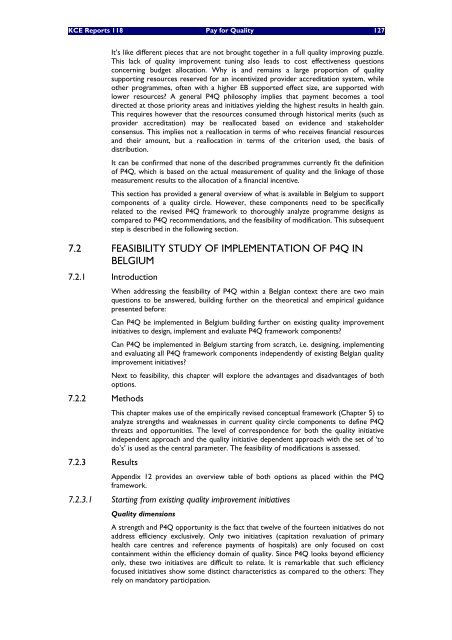Pay for Quality
Pay for Quality
Pay for Quality
Create successful ePaper yourself
Turn your PDF publications into a flip-book with our unique Google optimized e-Paper software.
KCE Reports 118 <strong>Pay</strong> <strong>for</strong> <strong>Quality</strong> 127<br />
It’s like different pieces that are not brought together in a full quality improving puzzle.<br />
This lack of quality improvement tuning also leads to cost effectiveness questions<br />
concerning budget allocation. Why is and remains a large proportion of quality<br />
supporting resources reserved <strong>for</strong> an incentivized provider accreditation system, while<br />
other programmes, often with a higher EB supported effect size, are supported with<br />
lower resources? A general P4Q philosophy implies that payment becomes a tool<br />
directed at those priority areas and initiatives yielding the highest results in health gain.<br />
This requires however that the resources consumed through historical merits (such as<br />
provider accreditation) may be reallocated based on evidence and stakeholder<br />
consensus. This implies not a reallocation in terms of who receives financial resources<br />
and their amount, but a reallocation in terms of the criterion used, the basis of<br />
distribution.<br />
It can be confirmed that none of the described programmes currently fit the definition<br />
of P4Q, which is based on the actual measurement of quality and the linkage of those<br />
measurement results to the allocation of a financial incentive.<br />
This section has provided a general overview of what is available in Belgium to support<br />
components of a quality circle. However, these components need to be specifically<br />
related to the revised P4Q framework to thoroughly analyze programme designs as<br />
compared to P4Q recommendations, and the feasibility of modification. This subsequent<br />
step is described in the following section.<br />
7.2 FEASIBILITY STUDY OF IMPLEMENTATION OF P4Q IN<br />
BELGIUM<br />
7.2.1 Introduction<br />
When addressing the feasibility of P4Q within a Belgian context there are two main<br />
questions to be answered, building further on the theoretical and empirical guidance<br />
presented be<strong>for</strong>e:<br />
Can P4Q be implemented in Belgium building further on existing quality improvement<br />
initiatives to design, implement and evaluate P4Q framework components?<br />
Can P4Q be implemented in Belgium starting from scratch, i.e. designing, implementing<br />
and evaluating all P4Q framework components independently of existing Belgian quality<br />
improvement initiatives?<br />
Next to feasibility, this chapter will explore the advantages and disadvantages of both<br />
options.<br />
7.2.2 Methods<br />
7.2.3 Results<br />
This chapter makes use of the empirically revised conceptual framework (Chapter 5) to<br />
analyze strengths and weaknesses in current quality circle components to define P4Q<br />
threats and opportunities. The level of correspondence <strong>for</strong> both the quality initiative<br />
independent approach and the quality initiative dependent approach with the set of ‘to<br />
do’s’ is used as the central parameter. The feasibility of modifications is assessed.<br />
Appendix 12 provides an overview table of both options as placed within the P4Q<br />
framework.<br />
7.2.3.1 Starting from existing quality improvement initiatives<br />
<strong>Quality</strong> dimensions<br />
A strength and P4Q opportunity is the fact that twelve of the fourteen initiatives do not<br />
address efficiency exclusively. Only two initiatives (capitation revaluation of primary<br />
health care centres and reference payments of hospitals) are only focused on cost<br />
containment within the efficiency domain of quality. Since P4Q looks beyond efficiency<br />
only, these two initiatives are difficult to relate. It is remarkable that such efficiency<br />
focused initiatives show some distinct characteristics as compared to the others: They<br />
rely on mandatory participation.
















